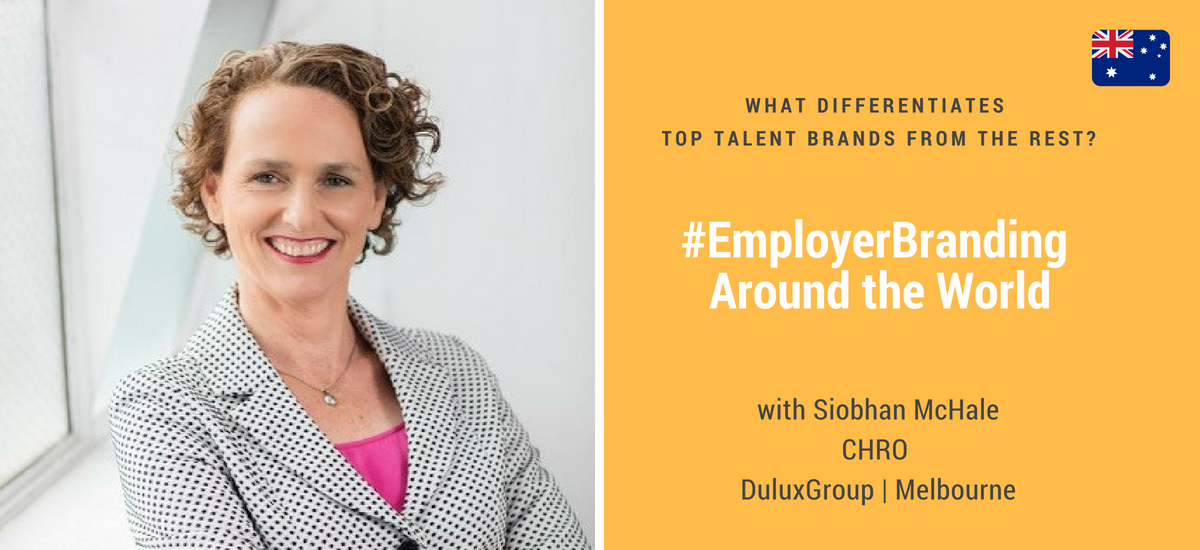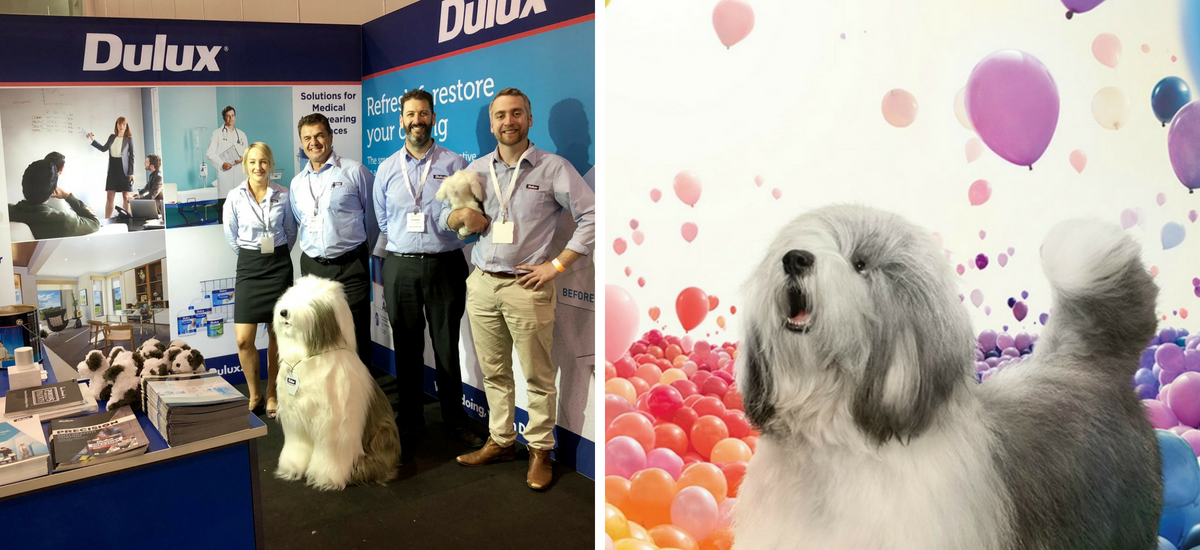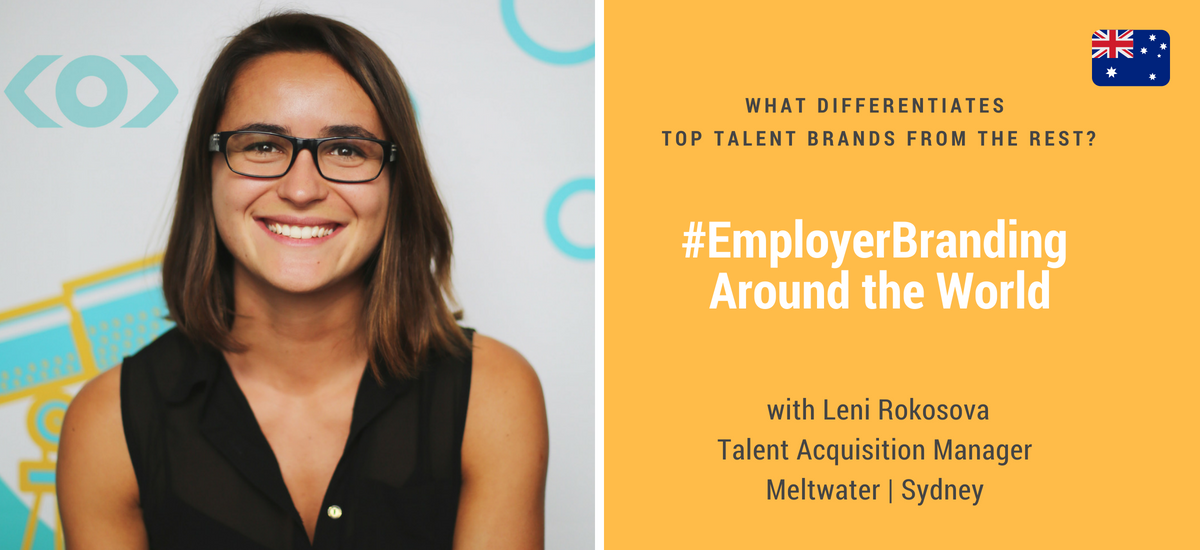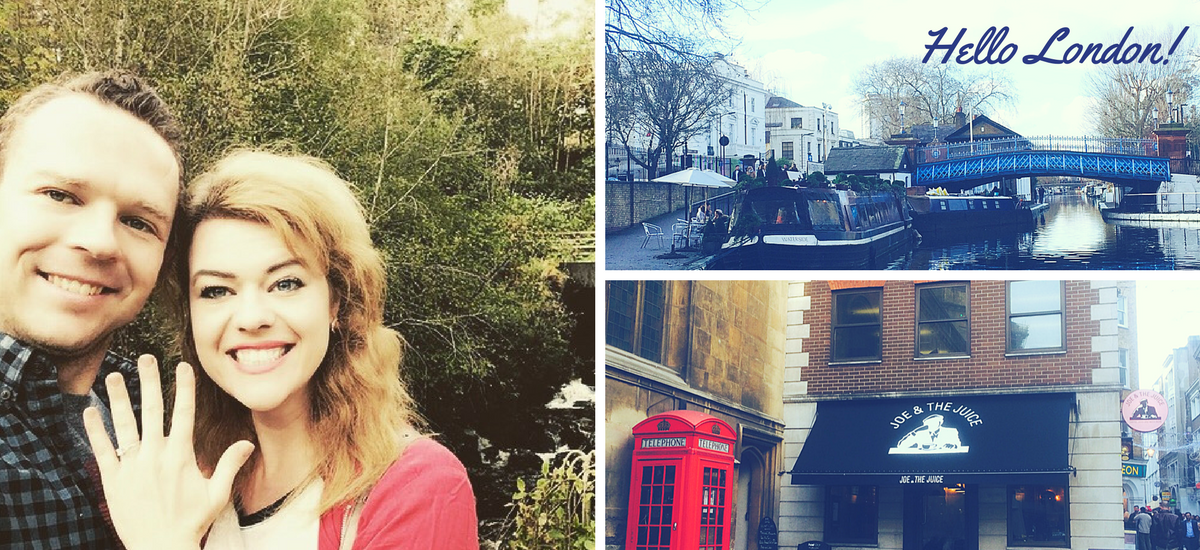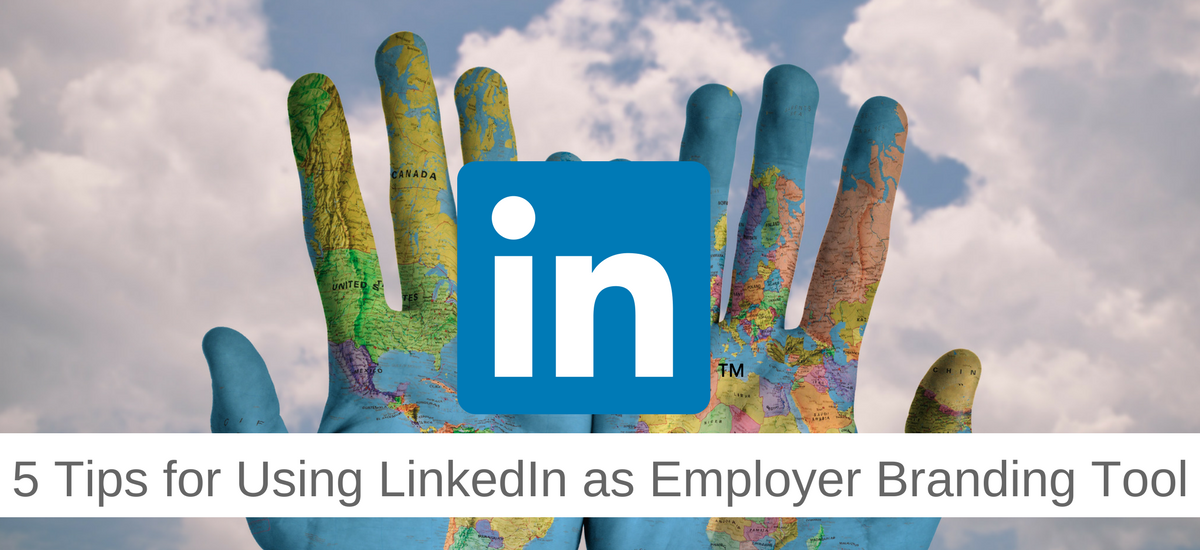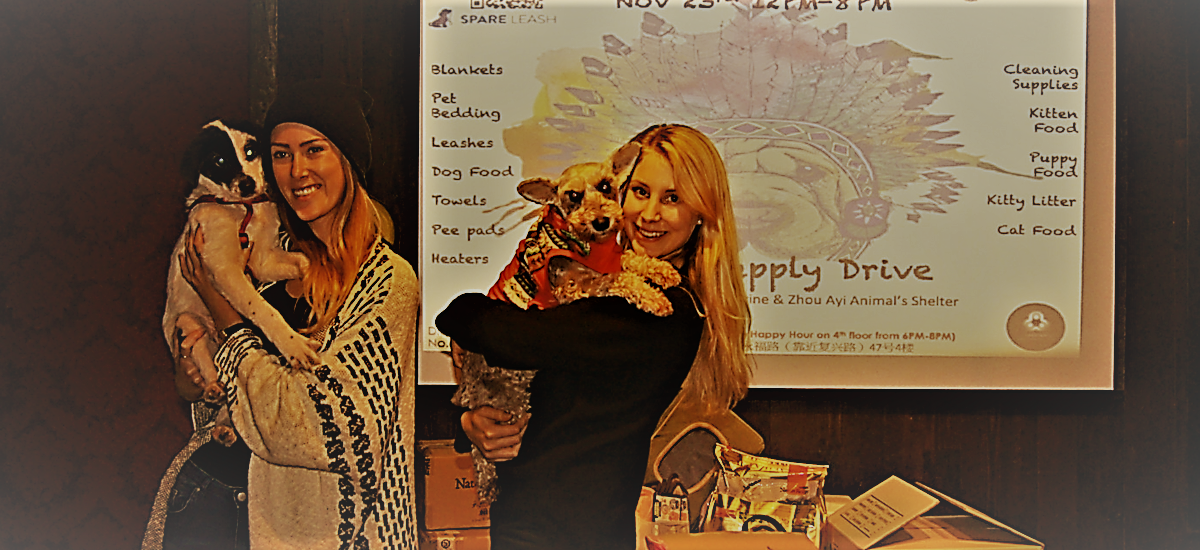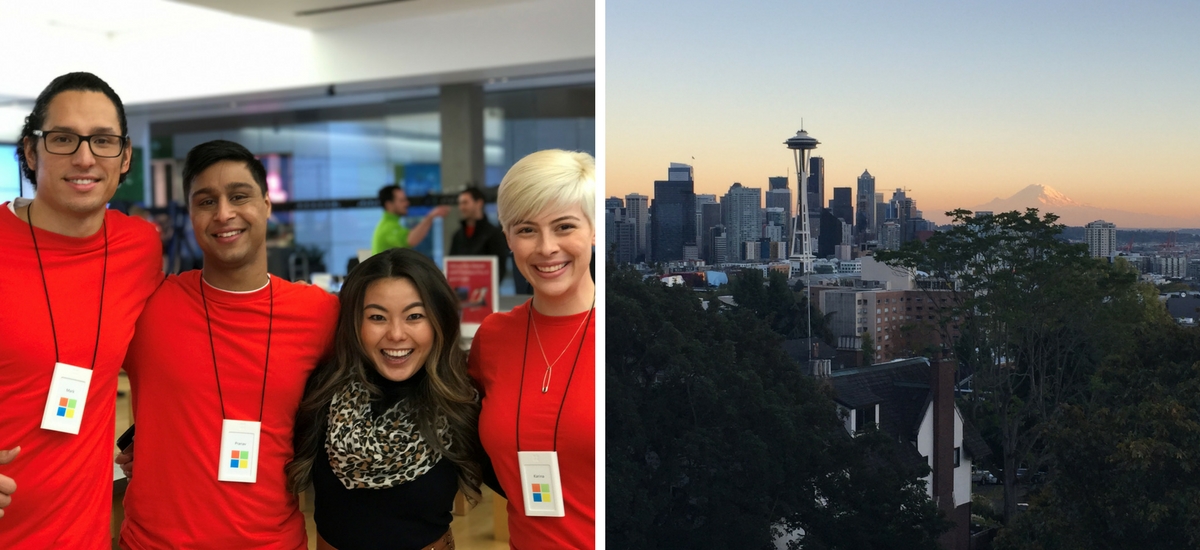Human Resources, Leadership, Modern Career, Talent Branding
Employer Branding Around the World with Siobhan McHale.
Siobhan, can you tell us more about yourself and your job?
I’m a culture change specialist with a vision to make workplaces better. I’m employed as the Head of Human Resources at DuluxGroup – a successful, growing international consumer goods company based in Melbourne, where my focus in on creating a more consumer-oriented and growth focused culture.
I trained as an organizational psychologist and hold a BA in Psychology and a Masters degree in Occupational Psychology from University of Sheffield, England. I began my career as a management consultant at PricewaterHouse Coopers in London where I crisscrossed Europe helping clients create successful culture transformations. In this role I advised leaders across four continents about how to create more vibrant and productive work environments.
In 1994 I grew tired of the long, wet English winters and moved to Australia, where I continued my work as a change advisor with Accenture.
After a decade as a consultant I wanted to put some “skin in the game” and decided to test all that I had learned in an actual corporate setting. I was employed as the executive in charge of change in a series of large, complex organizations. In these workplaces I was no longer operating as an outsider but actually getting my hands dirty working in the challenging and often messy trenches of transformation. These “insider” positions gave me a markedly different perspective on workplace change.
 You have an impressive a track record of creating more engaged businesses across four continents. What is the connection between engaged employees and a strong talent brand?
You have an impressive a track record of creating more engaged businesses across four continents. What is the connection between engaged employees and a strong talent brand?
I worked at Accenture which is one of the biggest consulting firms in the world. Within 3 months of joining I had moved countries from Australia to New Zealand and was working in the retail sector, which was completely new to me. I was on an accelerated learning curve but my experience in the consulting firm was completely aligned with the promise that I had been ‘sold’ when I interviewed for the job. I was told by the partners that I was entering a fast-paced, stretch culture where I was expected to be agile. I was not surprised when, three months after I had joined, I was asked to move countries.
The important thing with your employer brand is that it is congruent with the ‘deal’ that you are espousing to employees. When there is misalignment between the promise and the deal, then that’s when you get noise. So, for instance, if you are telling people that they can expect a highly engaged workplace and you don’t deliver on this promise then employees will be disappointed when they enter your firm. The clearer you can be about the expectations and the closer you can deliver to these, the better.
DuluxGroup has a quite unusual Brand Ambassador. Can you tell us more about him?
Yes, our brand ambassador is an Old English Sheepdog called Digby. Our employees love Digby and he shows up to staff events where there is typically a queue to get a photo taken with him. The dog was first introduced in advertising campaigns in 1961. Since then the sheepdog has been a constant and highly popular feature of Dulux television and print adverts wherever the paint is sold. So much so, that many people in those markets refer to the breed as a ‘Dulux dog’ rather than a sheepdog. Over the years, different dogs have appeared in the adverts. However, they all look very similar and Fernville Lord Digby, was the most famous Dulux dog.
Digital Trends, Human Resources, Modern Career, Talent Branding
Employer Branding Around the World with Leni Rokosova.
Originally from Czech Republic, Leni sees herself as a global citizen. Her background is in linguistics and international relations which led her to explore the world on the path to matching the best talent with amazing career opportunities. She has lived and worked in seven different countries and enjoys getting to know a new culture and immerse into it. She is currently working as a Talent Acquisition Manager for Meltwater in their Sydney office, responsible for full cycle hiring across all their departments in Australia and New Zealand.
Leni, congratulations for Meltwater being awarded the Top 7 Best Place to Work in Australia in 2017 and Top 12 Best Place to Work in Asia in 2018, as well as being one of 2016, 2017 & 2018 Great Place to Work Awards Winners in Canada. Can you share some secretes of your company success: what are the best practices of talent attraction and retention at Meltwater?
What attracted me to Meltwater was the fact that the company has managed to establish itself as a global leader in media monitoring with 60+ offices in less than 17 years! However, despite the success and growth we are experiencing, candidates I approach on LinkedIn typically have not heard about us, but when they do their research, they’re always surprised that they have not come across us yet!
Our target market is Gen Y (also known as Millennials), it is well reported that personal growth and career development is the key factor in choosing a suitable employer for this generation. As such Meltwater is extremely conscious of building a culture that facilitates that experience, we challenge our employees from day one to be the best version of themselves. We work in a fast-paced environment, things change quickly so our new recruits need to be agile and learn quickly.
Research also shows Gen Y wants to be connected to the work they’re doing and for us, that means ensuring there is a sense of shared purpose. There is plenty of time spent with line managers and even though these meetings may sometimes seem like simple catch ups, the regularity achieves a greater purpose. A constant two-way feedback ensures people feel they have a seat at the table, they are given a platform to speak up and make an impact on the business and its culture.
Last but not least, we promote based on merits, not tenure. Drive and determination and your ability to realize your potential quickly are what determines the speed at which your progress. You can easily check this by a simple search of our employees on LinkedIn.
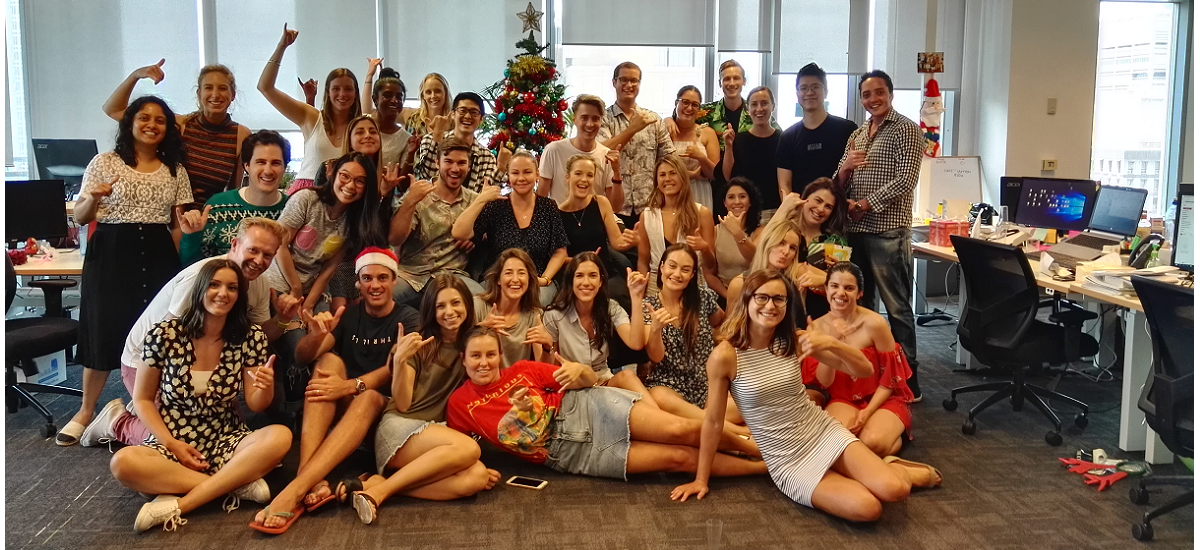
Is building a strong talent brand a “must have” or “nice to have” for modern employers?
Definitely a “must have”. Especially for Gen Y, they want to be coming to a place where they don’t only do what they enjoy doing but also a place where they feel welcome and are surrounded by like-minded individuals. Showing them what our culture is about, what our workplace looks like (maybe even giving them a sneak peek into our office playlists), how we celebrate success and what we do together outside of our workplace, is a no-brainer. This way they will already anticipate if this is an environment they would love to be part of or not.
What has been the process of building a strong talent brand at Meltwater?
We don’t have a designated team or employees for building our talent brand. I believe this should be a common effort of recruitment, marketing and HR, but, ultimately, all employees are responsible for this. Of course, all of us have a slightly different goal but at the end of the day, we all want to increase our brand awareness. I drive different initiatives, such as encouraging our employees to write blog posts, partner with top universities and students’ societies and provide training to all newbies (regardless of what team they join) on how to manage/promote our brand on LinkedIn. I already started this in my last job and it worked really well so took it over with me to Meltwater. It only takes about 15 minutes (if they’re in Sydney, its F2F, if in any other office, it’s via a video Skype call) but you would be surprised how little people know about different functions on LinkedIn and how to use them to your advantage. I always start the training with showing them some numbers on how many people interact with our brand on daily basis which always leads them to understand why this training is so important.
What is your social media strategy when it comes to employer branding?
I’m a huge advocate of LinkedIn and that’s where I spend lots of my time during the day. From my experience, the most quality talent is right there and it’s easy to tap into. On the other hand, it is true that the Gen Y don’t necessarily have a LinkedIn profile (yet!) and so it is important to build a strong strategy on their favourite social channels, such as Instagram and Snapchat – this is work in progress for us right now!
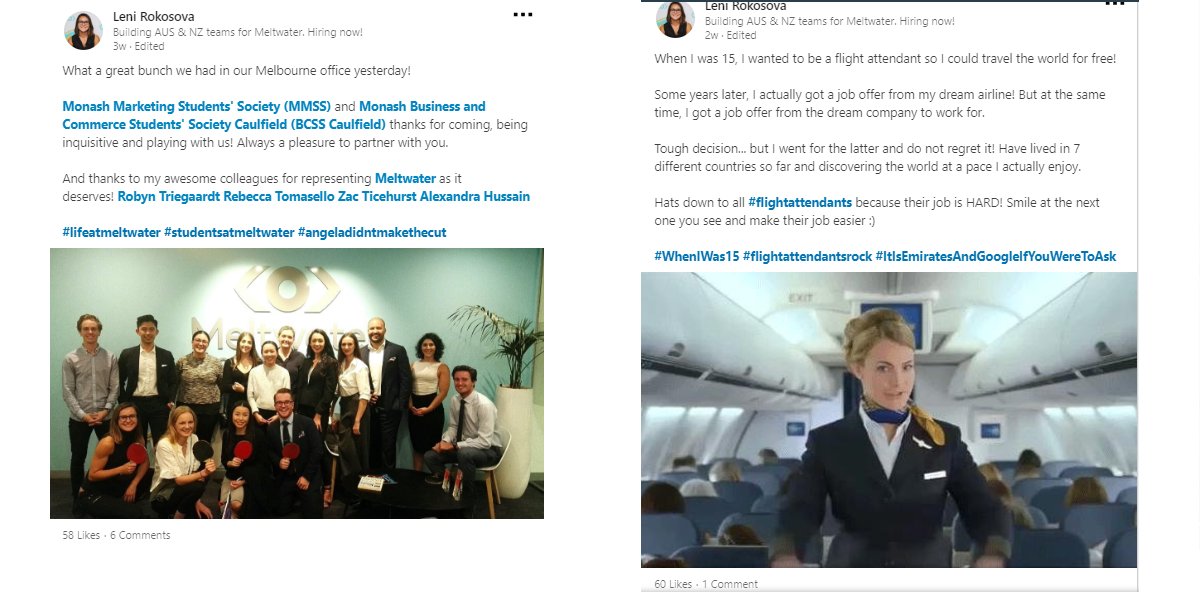
How do you use content marketing and storytelling methods on LinkedIn to generate stronger candidate pipelines?
As mentioned before, I love LinkedIn and consider content marketing as a great tool for raising brand awareness. I always make sure my posts have a purpose and most importantly, have a personal touch. Sharing only jobs, I’m currently hiring for wouldn’t make the cut! I divide my posts in 25% about our office life/culture, 25% about company updates, 25% about job posts (always accompanied by the right culture pic!) and 25% about my personal/professional interests. Sometimes it’s hard to keep the office life pictures to only 25% because there’s always something happening (ranging from a simple celebration of someone’s birthday – yes, everyone loves a good piece of cake! – through celebrating a new deal that just came in, to those crazy closing days when we always have a theme and dress up).
Modern Career, Modern Career Woman by Heather Schnacke, Relocation
Goodbye Prague, Hello London! Modern Career Woman – Chapter VI by Heather Schnacke
From my previous articles you might remember that I met a boy in London through mutual friends who is now officially my fiancé. We have been in a long-distance relationship for more than two years now – going back and forth between two magical cities. While not always easy, it has been quite an adventure to say the least. From exploring the two cities to nature walks outside to an American reality show (yep, that happened – my sidekick on the show is co-founder of Coachify) to even more travels in Europe, the USA, and South Africa, we have experienced a lot together so far. So now the time has come to officially be in the same place. While selfishly I wanted him in Prague, we knew that London made more sense for us in the long term. Prague is such an amazing city and it is truly a magical place. It is the only Czech word I can seem to remember – koulzena (magical)– as that’s all I think of when I turn every corner. I am so grateful for what this city has given me – a job that people told me would be hard if not impossible to find (“only Americans who are transferred with companies get jobs here besides teaching English”), the best colleagues (I am the only non-Czech person on my team and one of three in the entire company), an amazing work-life balance with a gym and grocery store only minutes away from my doorstep, and a lovely flat easily called home. I can even walk home from work which I take advantage of most day with a breathtaking view of the castle that doesn’t ever seem to get old.
#COACHIFYCHINA, Consulting, Digital Marketing, Digital Trends
7 Tips about Branding on WeChat for Beginners from Olivia Plotnick.
Olivia resides in Shanghai, China and works as the marketing manager for Brandigo, a global marketing and communications agency. She manages the company social media accounts, including WeChat, as well as the blog, content offers and promotion. She also manages the marketing and communications for Shanghai based free fitness community, FitFam, a volunteer-led organization with over 3,000 active members, and currently over 6,000 WeChat followers.
Olivia is recognized for her knowledge of marketing and branding in China; she was featured in Forbes and grew a WeChat account from 2,000 to 5,500 followers in just 6 months.
Today she shares with Coachify her top seven tips on using WeChat as a branding tool.
1. WeChat is a chatting app: engage, tell a story.
Branding in China is becoming more popular. In China or in Hong Kong when you are outside there are bright neons and signs everywhere. However, people are not paying attention to that, they don’t read advertisements on the windows anymore – everyone is looking at their phone. Especially young, Chinese consumers nowadays want to disconnect from all the noise of advertisement.
We are getting so focused on telling our own stories and getting involved in other people stories – just look at your WeChat moments. Why would brands be not doing it? Why would brand not tell their stories to better connect with people? The key question is: how can brands better connect with their customers?
Storytelling and personalization are the answers. WeChat is a chatting app, people are expecting it to be interactive, and personalized, that’s what they crave from this platform. They expect to receive content that they can relate to and connect with on a personal level. Elijah Whaley, CMO at PARKLU makes a great point in this article about the digital consumer in China – your WeChat, and other mobile channels for that matter, should be fun, engaging and useful.
2. Make it about people.
Data from Tencent shows that people prefer to see and share content about their lives and those close to them. Reach out to your community, your coworkers, your customers and get them involved.
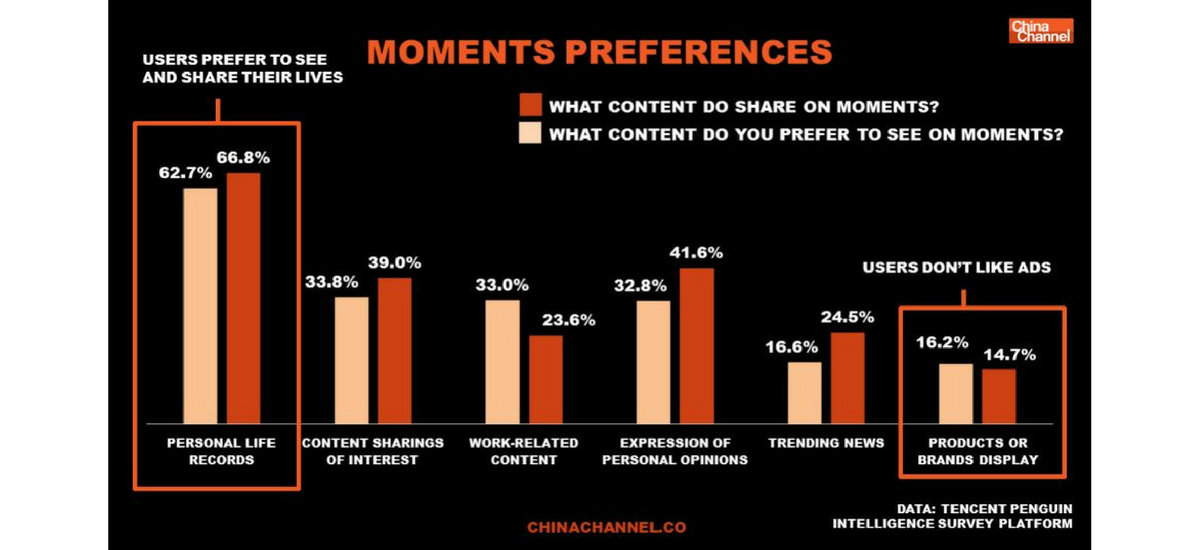
One of the most popular articles posted from the FitFam account was an article announcing an event in partnership with a women’s active wear brand. The article highlighted many of the reasons why people find the community so special, and what the core values mean to many of the young women in the community. It reached people on a personal, and emotional level, and ended with a call to action. It also included user-generated content in the form of photos that were taken of actual members of the community.
Other well-performing content comes from the FitFam partnership with Creative Humans writer Eduoard Bellin who interviews members of the FitFam community in-depth. These stories provide a window into the life of a friend, a workout partner – someone that people feel connected to and have an interest in learning about because he/she is part of their daily life.
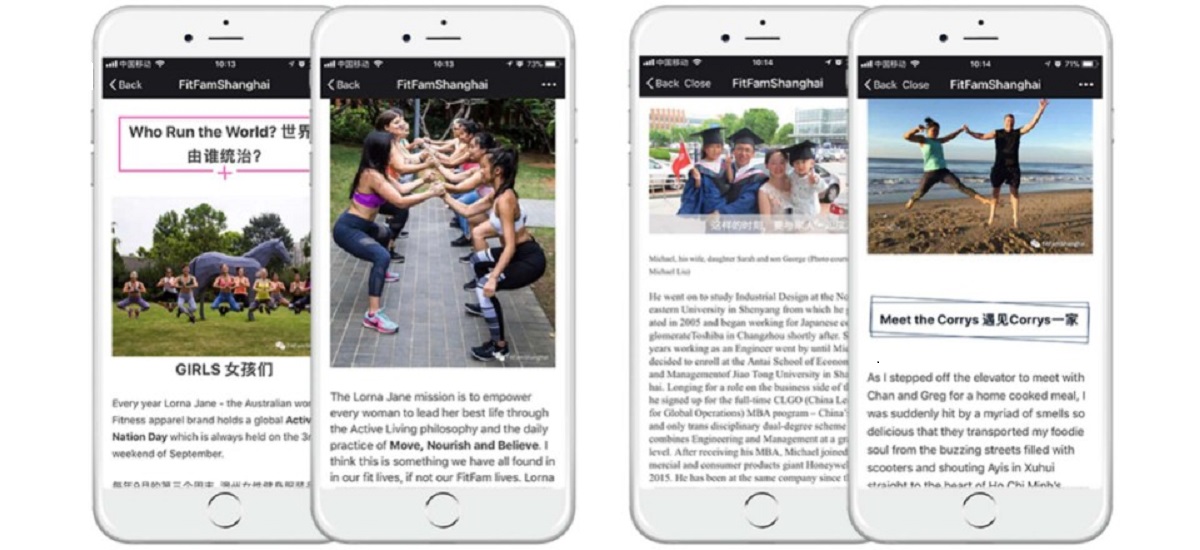
3. KOLs are a must.
This is especially true for B2C brands. KOLs or influencers are a key strategy for many brands. They’ve amassed their followers through blogging, thought-leadership, as well as leveraging their celebrity status. KOLs are usually well-trusted and have a much more personal relationship with their fans. As this Boston Consulting Group article states; In China, shopping is about more than just the transaction. It’s about entertainment, discovery, and social engagement with friends, celebrities, and internet influencers.
Chinese consumers trust influencers, and are not as put-off by sponsored content as much as their Western counterparts. In fact, many KOLs have done such a good job building up their fan base and making a niche for themselves that many have their own online stores on Taobao and Tmall where they are making millions selling products.
Make sure you set the right expectations in terms of your budget and do your research carefully before selecting a KOL to work with your brand.
Consulting, Digital Marketing, Digital Trends, Human Resources, Leadership
5 Tips for Using LinkedIn as Employer Branding Tool.
LinkedIn is not only a powerful tool that modern recruiters use to source candidates, but also an emergent employer branding platform that many companies have started to appreciate.
Read on to learn how the recruiters, HR and employer branding specialists from the different parts of the world generate stronger candidates’ pipelines by using content marketing and storytelling.
1.Introduce Social Media / LinkedIn Training
Did you know that employees have 10 times more connections on average than a company has followers? To leverage your employees personal brand and network introduce Social Media / LinkedIn training.
For example, Dell’s HR strategy including social media training resulted in higher quality hires, lower turnover and better engagement rates for Dell.
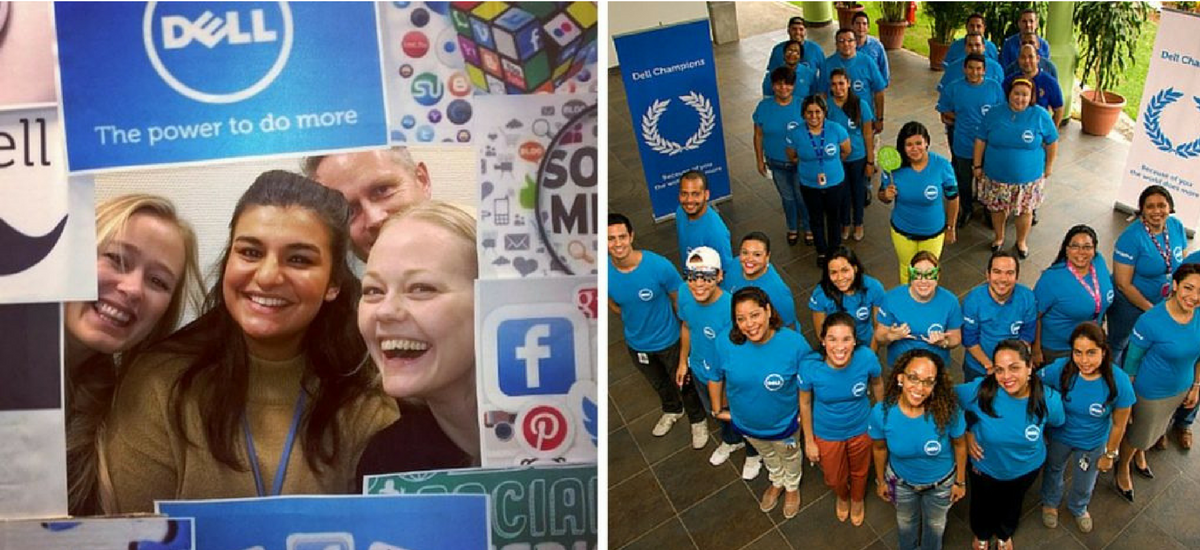 “We have trained to date over 16,000 employees! We also train our summer interns as part of their development and introduction to Dell. The biggest success is the ongoing focus on the program including monthly power hours by topic (how to deal with trolls, what is the deal with SnapChat, etc.) as well as the revisiting and updating of the content. The opportunity we have is to continue to have executives model this activity and behaviour.” – says Jennifer Jones Newbill, Senior Manager, Global Candidate Attraction, Engagement and Experience at Dell.
“We have trained to date over 16,000 employees! We also train our summer interns as part of their development and introduction to Dell. The biggest success is the ongoing focus on the program including monthly power hours by topic (how to deal with trolls, what is the deal with SnapChat, etc.) as well as the revisiting and updating of the content. The opportunity we have is to continue to have executives model this activity and behaviour.” – says Jennifer Jones Newbill, Senior Manager, Global Candidate Attraction, Engagement and Experience at Dell.
Click HERE to read our case study About social media and recruiting with Jennifer Jones Newbill from Dell.
2. Empower your employees to tell the story about the company
Of course, they need to love their work in a first place, and the post should come from them, you cannot simply order a praising article. Readers will only spend their precious time on reading and sharing authentic stories. Pay attention to employees who already blog or vlog. Often those who relocate will be interested in documenting they journey.
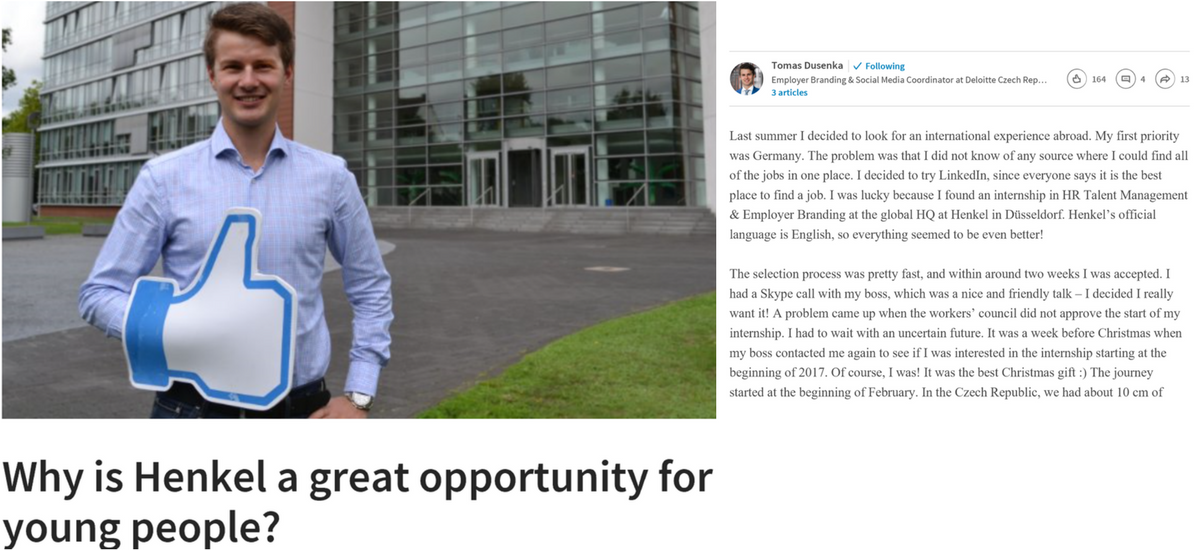
3. Enchant your staff
Delight the staff with a small gesture or help when it is not expected, for example offering them flexible work arrangements or even showing that you listen, and you care:
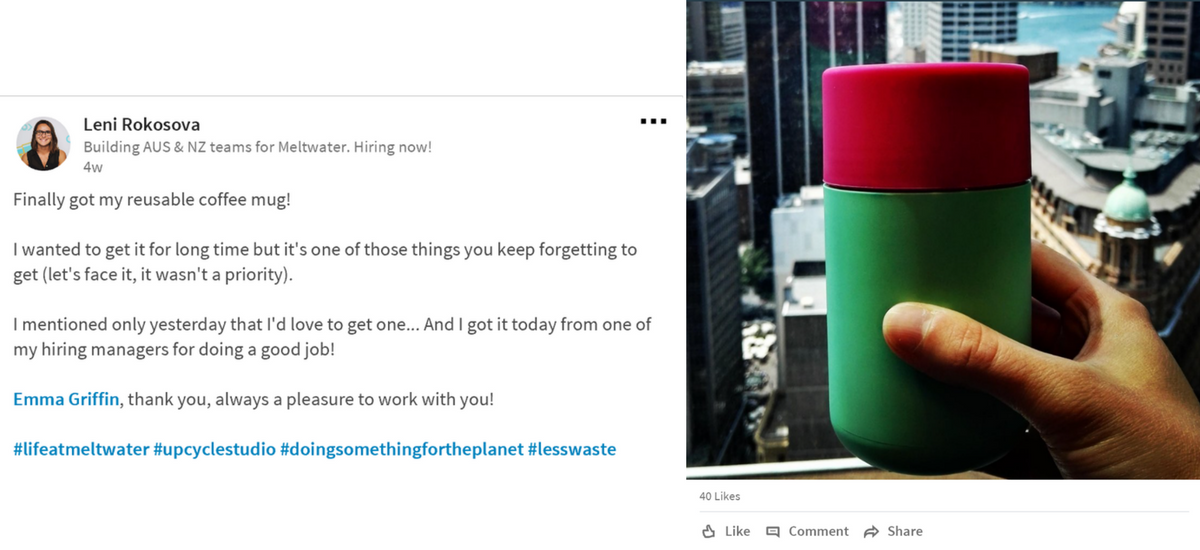 “When you enchant people, your goal is not make money from them or get them to do what you want, but to fill them with delight.”
“When you enchant people, your goal is not make money from them or get them to do what you want, but to fill them with delight.”
“(…) in a world of mass media, social media, and advertising media, it takes more than instant shallow, and temporary relationships to get the job done.”
Guy Kawasaki, Enchantment
4. Communicate your innovative HR policies
Challenge yourself (and your top management) to introduce a HR policy that could be shared as an interesting story.
Impossible? Here is the update from BrewDog:
“Thrilled to find out today that BrewDog have been shortlisted as a finalist in the 2018 Scottish Top Employers for Working Families Awards, in the ‘Best for Innovation’ category, for our Pawternity Leave initiative! (…)”
Seems standard but wait, did they misspell “paternity”? Or…
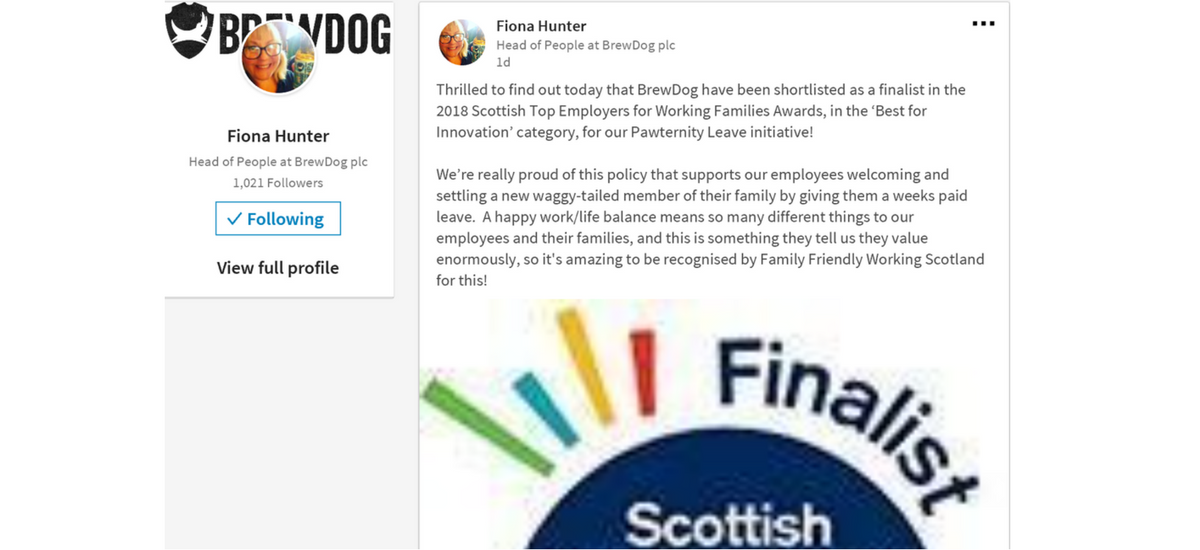
5. Measure success on your LinkedIn company page
Even if your company already has its LinkedIn page, you might strongly consider setting up a new page for your geographical region.
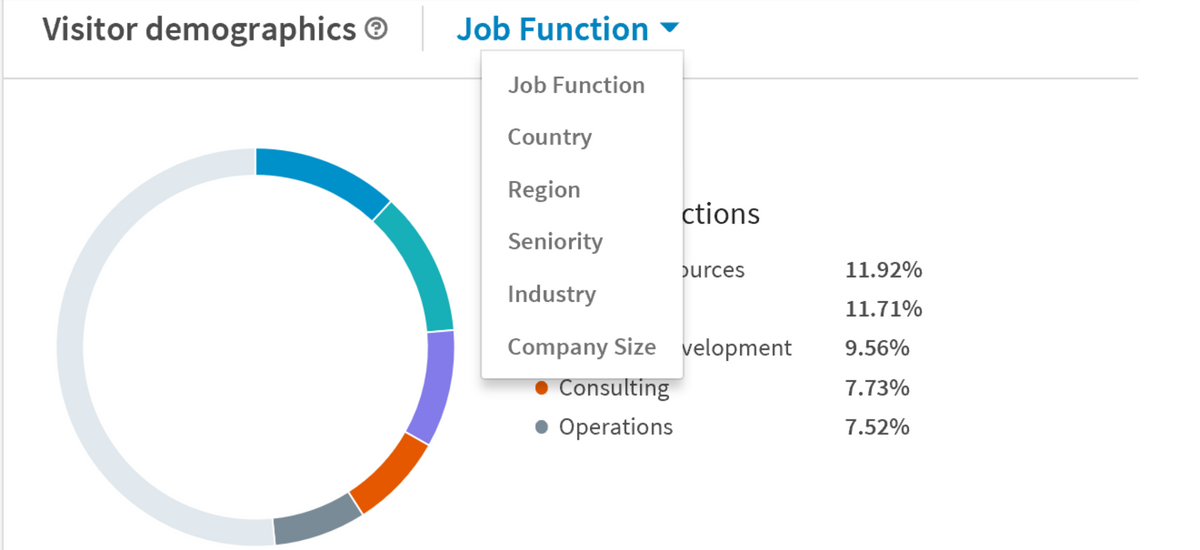
A simple company page is free yet give you some visitor demographics and some invaluable metric tools such as updates engagement and followers acquired in a specific month, week or even day.
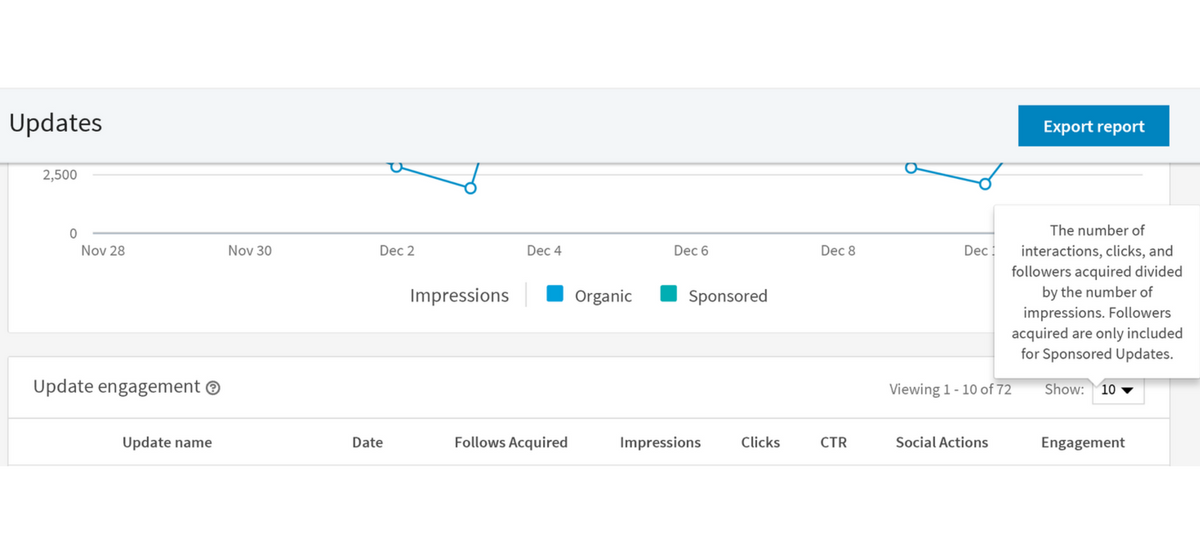 Followers acquired are only included for sponsored updates. You could still measure the success of your organic (not paid) updates, by looking at the followers acquired on a given day if you post no more than one update per day.
Followers acquired are only included for sponsored updates. You could still measure the success of your organic (not paid) updates, by looking at the followers acquired on a given day if you post no more than one update per day.
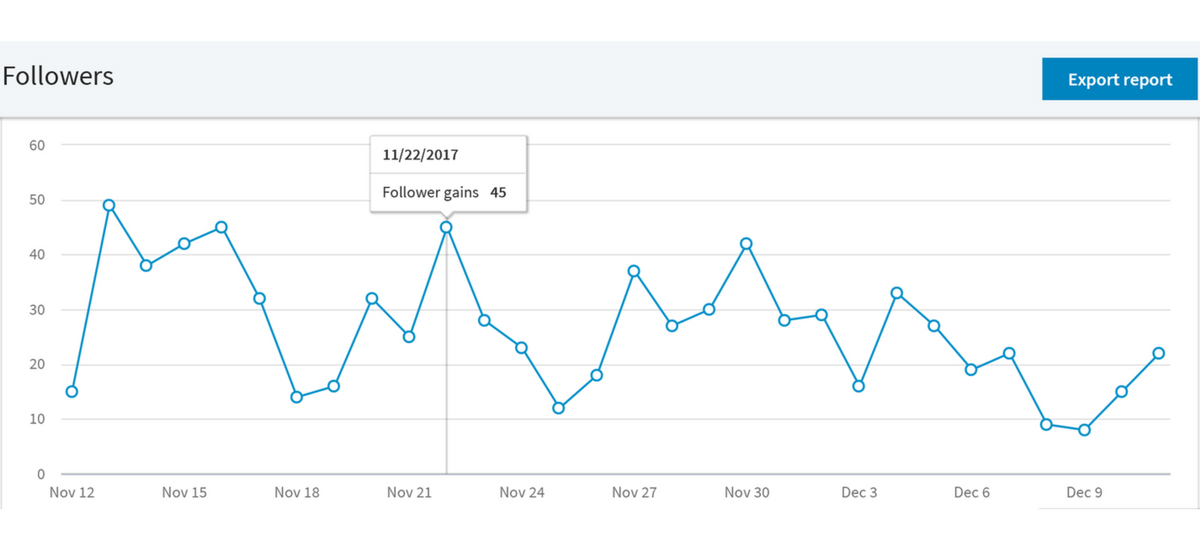
This article was inspired by the companies and experts from Scotland, Germany, Czech Republic, Australia, and China.
What are your favorite company updates or ideas for using LinkedIn as employer branding tool? Reach out on LinkedIn or Facebook; we would love to hear about the examples from other countries.
Beata Dziedzic
Digital Marketing, Digital Trends, Modern Career, Relocation
How to Find a Career in China, Get Featured on Forbes and Use LinkedIn to Its Full Potential.
From the rural Pacific Northwest to the middle of a concrete jungle, Olivia Plotnick has made it her mission to never stop challenging herself to reach new horizons. Making the decision to move to China by herself several years ago she has quickly learned how to build a personal network from scratch, become recognized for her knowledge of marketing and branding in China, get featured in Forbes and grow a WeChat account from 2,000 to 5,500 followers in just 6 months.
Olivia, what is the story behind your move to China?
I started studying Chinese at St. Mary’s High School. It was the first high school in Oregon to offer Chinese program. The summer after my first year of studying we had an opportunity to come China and I was one of the seven students selected. We travelled all around China during the holiday, it was my first trip outside of the States. It was the Summer 2007, and we went to Beijing, Henan, and the southern part of China, Kunming in the Yunnan province. It was so different from anything I had known or been exposed to before. After that experience, I started thinking that this is the path that I wanted to follow. I studied Chinese and business throughout college and I completed my final six months of college in Beijing, at Beijing Language and Culture University. I moved there by myself and enrolled in an intensive language program. The classes were only taught in Chinese and I was the only American in my class, with no other native English speakers. I think I cried a lot (laugh) and I was a little bit miserable for about five months, but by the sixth month I was loving it: I have this distinctive memory of riding in a cab and passing all these incredible buildings in Beijing. The energy from the city was electrifying. I went back to Oregon, graduated and found a job at an international adoption agency. I was helping prospective parents through the first 1 to 2 years of the adoption process. I was also helping to update the organization’s website to drive more traffic and liaising with our Beijing office. While this role was a huge learning opportunity for me, I knew it wasn’t my career path. I really wanted to move back to China and pursue a career in international business.
Coaching, Human Resources, Modern Career, Relocation
Career transition – from London to China.
千里之行,始於足下.
A journey of a thousand miles begins with a single step.
Lao-tzu, Chinese Philosopher (604 BC – 531 BC)
In 2011 I quit my job in SAP recruitment in London and moved to China. Little did I know what was going to happen, but I hoped that the relocation would help me change my career.
I didn’t love my job, but I didn’t strongly dislike it either. As everywhere, it had its rainy Monday mornings when commuters were rushing through the Liverpool Station. Everyone seemed stressed out and unhappy about starting a new week in the City. However, as soon as I would get inside the office and make my coffee while chatting with colleagues, it didn’t seem that bad. ‘I can do it, I can get through another week, if I only survived Monday’ I would say to myself. There was also the thrill of headhunting, the constant buzz in the office, and a lot of laughs. Life was good and the closer to the weekend the better it was becoming. Around Wednesday, emails from my friends were starting to circulate as we were preparing for another fabulous weekend in London. It rarely happens that we are entirely happy or unhappy in our job, and I guess that makes any decision harder. When is the cutting off moment when we say: “I’m done with it and ready for a new role”? Once we have reached that stage another obstacle appears – we don’t have clarity on what we WANT.
I realized that what bothered me the most about my job was the fact that I didn’t feel challenged anymore. I didn’t want to live only for the weekend. I thought about moving to internal HR, as that was one of the most common “career transitions” for agency recruiters. I was also asking myself when was the last time I was happy at my job? The answer was three years ago, working as an executive search consultant in the energy sector. With that in mind, I was considering going back to the executive search. Then my boyfriend got a job offer in Beijing. We discussed three options: a long-distance relationship, me staying in London and trying to job hunt in Beijing, or finally quitting my job and relocating together. From a recruiter perspective, I knew that being in the right location could make a huge difference. Firstly, my CV with London and the UK number on it could go into the “bin folder” in a matter of seconds. Secondly, meeting hiring managers face to face is a small difference that makes the all the difference.
While discussing relocation, we also decided to get married. Three weeks later, on a Monday morning, I was rushing through Liverpool Station to work. I was going straight from the airport and I asked my manager if we could have a meeting. He knew I just came back from Las Vegas, he wasn’t particularly surprised about the marriage decision. However, he didn’t expect the news that I was now moving to Beijing.
I was moving to a country that I haven’t visited before. I didn’t know anyone there and I didn’t speak the language. A country that scores at the top of the most difficult places to live and work in the world. The goal was to find a new career path and I was excited about it, especially about the fact that everything was going to be different.
What happened in China?
Adding Value, Leadership, Location independent, Modern Career, Relocation
About entrepreneurship in China with co-founders of Spare Leash
Originally from Sweden, Elsa Medin relocated to Shanghai four years ago to study Chinese. She decided to stay in China and did her bachelor degree in international business. With her motto being “If I cannot find the path, I will create it!” she launched Spare Leash right after graduation. Elsa has a dog named Betsy, a schnauzer adopted in Shanghai in October 2016. She also fosters dogs.
Erin Leigh studied public relations, advertising and applied communication at Western Michigan University. She came to China after graduating from college. She has been living in Shanghai for over five years, working in PR and marketing, before co-founding Spare Leash. Erin has Oliver (labrador mix), Betty (mini schnauzer), and Max (terrier mix). They used to be foster animals, but she ended up adopting them. Erin usually fosters one more dog every month. She also rescues kittens; she bottle-feeds them and looks after them while searching for adopters.
Spare Leash is dedicated to making life easier for pets and pet owners by providing loving and trustworthy pet sitters in Shanghai. Their services are safe, reliable and cage free. The company was founded in Shanghai, in 2016. In the same year, Spare Leash was awarded by Time Out Love Shanghai for Lifestyle Service of the Year.
How Spare Leash started?
Elsa: It began in 2016 when I wanted to adopt a dog from the street in Shanghai. I was still a student, and I was going traveling for a whole month. None of my friends could take care of him. Finally, I didn’t adopt this dog. However, I started to think how we can all help each other looking after pets when we travel. I had an idea, and I spent a few months thinking about Spare Leash and how I can make that happen. I had mutual friends with Erin. She was facilitating pets’ adoptions in Shanghai.
Erin: One day, Elsa texted me out of the blue, saying: “I need to talk to you. Meet me for lunch”. We met at one of my favorite restaurants, Kommune. Elsa told me about her idea. It was also a part of her university project.
Elsa: I had a class called Entrepreneurship, and that’s how I started to look at it from a business perspective. My initial idea was a pet hotel, but I wasn’t 100% happy with that and kept on brainstorming. I went to Australia for a month, and because I didn’t adopt the dog, I was thinking about it during the whole trip. I was doing my research, writing down my ideas and a business plan. When I came back, I met Erin.
Erin: Elsa nearly had a business plan and the avenue laid out, as well as the name and the logo. Right away I said: YES. The very next day we were in my living room, my three dogs were running around, and we were starting the business. It was around early April. I had just quit my job in PR.
Elsa: I was in the last semester of my Bachelor’s degree majoring in business. I had in my final exams. My final thesis was about the WeChat business, so I was going to many business events and learning from hands-on entrepreneurs.
Erin: We first built a website, which took a month. Then we had a launch party – a charity event co-organized with Best Friends China.
Elsa: We got our first client during this event. The first interviews with sitters happened in Erin’s apartment.
Adding Value, Modern Career, Relocation
How to volunteer and engage with a local community during your busy life abroad? #AddingValue series
About Tiziana:
Tiziana Figliolia is the Sr. Vice President, Global Business Operations and Finance at PTC. She is also the President and Board Member of International Professional Women Association (IPWS) in Shanghai, and a speaker on the topic of gender diversity, equality and women empowerment (Women TEDx Shanghai Salon, Shanghai International Forum on Women’s Development).
Tiziana is a global leader with 20 years of experience working with technology companies publicly traded and startups, with a wide range of strategy, planning, finance, customer support, sales & operations, R&D, and business partnering related responsibilities. As a native Italian and after graduating in Economics, Tiziana realized that moving to the USA was the right choice to springboard her career. Being a naturally curious and open minded person, Tiziana relocated a few times with her family and progressed her career around the world. Currently, she lives with her husband and son in Shanghai, a city, which she finds the most international and cosmopolitan from all the international cities.
About IPWS:
International Professional Women’s Society is a non-profit organization that provides professional women with different platforms to connect and foster personal and professional growth. IPWS has a community reach of more than 2000 women.
***
Tiziana talks with Coachify about her motivations to volunteer, engage with a local community and empower professional women, as well as how it helped her to live a fulfilled life. One of the lessons we can learn from her is: choose a volunteering project or community that resonates with your life vision and passion.
Tiziana, how did you become interested in IPWS?
After working for some time in China, and completing my MBA, I felt there was a void in my life, which needed to be filled. I’ve accomplished a lot professionally, I have a great family, but I needed more to fulfill my purpose. More than the traditional work/life balance, I believe in living an integrated life where professional, personal (family) and social (giving back to the community) are interconnected and a measure of who we are, what we do and how we accomplish our life goals. These are three very fundamental parts of who I am. At the time I felt that the social aspect was incomplete. I asked myself: How do I give back? How do I make an impact on the community? I started to look around, and when my friend Margot invited me to an IPWS event, I joined. I enjoyed the crowd and the ambiance of the event and worked my way to join the Board of Directors and become the President of the organization, now for the past four years. IPWS was and still is an excellent fit in terms what I was trying to achieve.
Digital Marketing, Digital Trends, Human Resources, Modern Career
About social recruiting and personal branding with Maasa Walker
Maasa, can you please tell us about yourself?
I love being able to connect with talent digitally and in-person and especially leveraging social media to tell a story behind some of the jobs that I recruit for.
I’ve been recruiting for the last 5.5 years, working across various industries ranging from healthcare, IT, marketing, creative, retail in both agency and corporate settings. I’ve been fortunate to recruit for many top brands & companies including Microsoft, Starbucks, Amazon, and Expedia.
Social media allows recruiters to connect with prospects in a more meaningful, authentic, and engaging ways than the traditional “submit and pray” system. For me, this is the most exciting part of my job as a social recruiter. I especially love showing off “behind the scenes” content and information to talent – whether that be fun group photos of the team or writing and sharing a blog on the “human” aspect of each job, team or organization.
Your LinkedIn summary is very impressive. It has all the “right ingredients” of a powerful summary, which are: storytelling, description of what you and your company do, call to action, keywords, and imagery. How did you come up with it?
Thank you! You know, in any profession, whether you’re a sales person, marketer or an engineer – there are tons of other people who do the same job you do. If you look across my network, I’m sure you can find many recruiters who have worked for the same organization or have held similar roles and I have. Given that situation, you have to figure out a way to stand out from the herd in an authentic and memorable way.
When I wrote this particular summary of mine, I thought about few things: 1) Who am I and what is my “brand”? 2) What are things I’m particularly good at? 3) What type of stuff gets me really excited?
The first part is really important – knowing your personal brand. Beyond being a recruiter at “company A” or being a specific industry recruiter, I have my own “flavor” or brand that I represent regardless of the company I work for or team I’m on. You have to have clarity & consistency in that brand & messaging.
The second piece is also important because that’s what makes you unique and different – your superpower if you will. You definitely need to understand the value you bring to the table and be able to celebrate that differentiator.
Third is being able to articulate the area of passion. This is where I ideally like to build more of my career on, and I think it’s beneficial for others to know as well. I’d like to think this is the reason why you reached out to me for an interview. I think overall you open up more doors by being transparent and letting others know what drives you.

